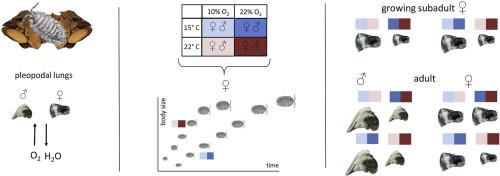当前位置:
X-MOL 学术
›
J. Therm. Biol.
›
论文详情
Our official English website, www.x-mol.net, welcomes your
feedback! (Note: you will need to create a separate account there.)
Thermal and oxygen conditions during development cause common rough woodlice (Porcellio scaber) to alter the size of their gas-exchange organs
Journal of Thermal Biology ( IF 2.9 ) Pub Date : 2020-05-01 , DOI: 10.1016/j.jtherbio.2020.102600 Andrzej Antoł 1 , Anna Maria Labecka 1 , Terézia Horváthová 2 , Bartosz Zieliński 3 , Natalia Szabla 1 , Yaroslav Vasko 3 , Anna Pecio 4 , Jan Kozłowski 1 , Marcin Czarnoleski 1
Journal of Thermal Biology ( IF 2.9 ) Pub Date : 2020-05-01 , DOI: 10.1016/j.jtherbio.2020.102600 Andrzej Antoł 1 , Anna Maria Labecka 1 , Terézia Horváthová 2 , Bartosz Zieliński 3 , Natalia Szabla 1 , Yaroslav Vasko 3 , Anna Pecio 4 , Jan Kozłowski 1 , Marcin Czarnoleski 1
Affiliation

|
Terrestrial isopods have evolved pleopodal lungs that provide access to the rich aerial supply of oxygen. However, isopods occupy conditions with wide and unpredictable thermal and oxygen gradients, suggesting that they might have evolved adaptive developmental plasticity in their respiratory organs to help meet metabolic demand over a wide range of oxygen conditions. To explore this plasticity, we conducted an experiment in which we reared common rough woodlice (Porcellio scaber) from eggs to maturation at different temperatures (15 and 22 °C) combined with different oxygen levels (10% and 22% O2). We sampled animals during development (only females) and then examined mature adults (both sexes). We compared woodlice between treatments with respect to the area of their pleopod exopodites (our proxy of lung size) and the shape of Bertalanffy's equations (our proxy of individual growth curves). Generally, males exhibited larger lungs than females relative to body size. Woodlice also grew relatively fast but achieved a decreased asymptotic body mass in response to warm conditions; the oxygen did not affect growth. Under hypoxia, growing females developed larger lungs compared to under normoxia, but only in the late stage of development. Among mature animals, this effect was present only in males. Woodlice reared under warm conditions had relatively small lungs, in both developing females (the effect was increased in relatively large females) and among mature males and females. Our results demonstrated that woodlice exhibit phenotypic plasticity in their lung size. We suggest that this plasticity helps woodlice equilibrate their gas exchange capacity to differences in the oxygen supply and metabolic demand along environmental temperature and oxygen gradients. The complex pattern of plasticity might indicate the effects of a balance between water conservation and oxygen uptake, which would be especially pronounced in mature females that need to generate an aqueous environment inside their brood pouch.
中文翻译:

发育过程中的热和氧气条件导致常见的粗糙木虱(Porcellio scaber)改变其气体交换器官的大小
陆生等足类动物进化出了腹足肺,可以获取丰富的空中氧气供应。然而,等足类动物占据的条件具有广泛且不可预测的热梯度和氧梯度,这表明它们可能在呼吸器官中进化出适应性发育可塑性,以帮助满足各种氧条件下的代谢需求。为了探索这种可塑性,我们进行了一项实验,在该实验中,我们将常见的粗木虱(Porcellio scaber)从鸡蛋中培养到在不同温度(15 和 22 °C)以及不同氧气含量(10% 和 22% O2)下成熟。我们在发育过程中对动物进行采样(仅雌性),然后检查成熟的成体(两性)。我们比较了治疗之间的木虱,它们的腹足外足的面积(我们代表肺大小)和 Bertalanffy 的形状 s 方程(我们代表个体增长曲线)。一般来说,相对于体型,男性比女性表现出更大的肺。Woodlice 的生长速度也相对较快,但在温暖条件下逐渐减少了体重。氧气不影响生长。在缺氧条件下,与常氧条件下相比,成长中的雌性发育出更大的肺,但仅限于发育后期。在成熟的动物中,这种影响只存在于雄性中。在温暖条件下饲养的木虱的肺相对较小,在发育中的雌性(在相对较大的雌性中影响增加)以及成熟的雄性和雌性中。我们的结果表明,木虱的肺大小表现出表型可塑性。我们认为这种可塑性有助于木虱平衡它们的气体交换能力,以适应环境温度和氧气梯度的氧气供应和代谢需求差异。可塑性的复杂模式可能表明水分保持和氧气吸收之间平衡的影响,这在需要在其育儿袋内产生水环境的成熟雌性中尤为明显。
更新日期:2020-05-01
中文翻译:

发育过程中的热和氧气条件导致常见的粗糙木虱(Porcellio scaber)改变其气体交换器官的大小
陆生等足类动物进化出了腹足肺,可以获取丰富的空中氧气供应。然而,等足类动物占据的条件具有广泛且不可预测的热梯度和氧梯度,这表明它们可能在呼吸器官中进化出适应性发育可塑性,以帮助满足各种氧条件下的代谢需求。为了探索这种可塑性,我们进行了一项实验,在该实验中,我们将常见的粗木虱(Porcellio scaber)从鸡蛋中培养到在不同温度(15 和 22 °C)以及不同氧气含量(10% 和 22% O2)下成熟。我们在发育过程中对动物进行采样(仅雌性),然后检查成熟的成体(两性)。我们比较了治疗之间的木虱,它们的腹足外足的面积(我们代表肺大小)和 Bertalanffy 的形状 s 方程(我们代表个体增长曲线)。一般来说,相对于体型,男性比女性表现出更大的肺。Woodlice 的生长速度也相对较快,但在温暖条件下逐渐减少了体重。氧气不影响生长。在缺氧条件下,与常氧条件下相比,成长中的雌性发育出更大的肺,但仅限于发育后期。在成熟的动物中,这种影响只存在于雄性中。在温暖条件下饲养的木虱的肺相对较小,在发育中的雌性(在相对较大的雌性中影响增加)以及成熟的雄性和雌性中。我们的结果表明,木虱的肺大小表现出表型可塑性。我们认为这种可塑性有助于木虱平衡它们的气体交换能力,以适应环境温度和氧气梯度的氧气供应和代谢需求差异。可塑性的复杂模式可能表明水分保持和氧气吸收之间平衡的影响,这在需要在其育儿袋内产生水环境的成熟雌性中尤为明显。









































 京公网安备 11010802027423号
京公网安备 11010802027423号